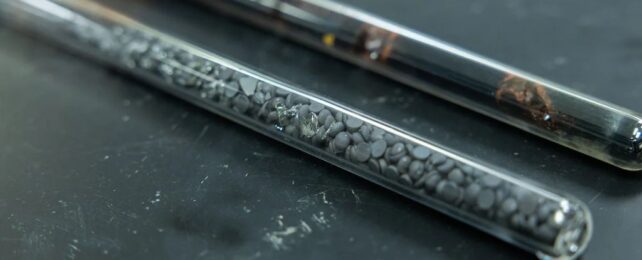Scientists have synthesized a form of glass that can knit itself back together after being damaged by gamma radiation.
Researchers observed films of chalcogenide glass with gamma-ray-induced defects gradually become whole again over time at room temperature, returning to a state of structural integrity without any other intervention.
The discovery, led by engineer Myungkoo Kang of Alfred University in the US, reveals a material that could be really useful in places like space environments, where gamma radiation is streaming constantly, or radioactive facilities where sensors durable to radiation would make a huge difference.
"People are increasingly looking at glasses that have similar optical transparency to crystals such as germanium that can be engineered for their composition and properties for use in applications where germanium may be used," says physicist Kathleen Richardson of the University of Central Florida.
"These glasses are seeing more and more use in systems where the community is looking for alternatives to some of the crystalline solutions that have historically been used before."
Glass is a pretty strange material at the best of times, but extremely useful in various ways. Chalcogenide glasses – those that include sulfur, selenium, tellurium, or polonium – interact with light in ways that make them useful for optical devices, especially in the realm of infrared sensing.
Kang and his colleagues were making just such a glass for use in satellite circuitry, using very precisely mixed amounts of sulfur, germanium, and antimony.
"These glasses exclude oxygen, and that's what makes them special for the infrared," Richardson says. "These are made of elements on the far-right side of the periodic table. When they bond together, they make very infrared-transparent materials but with very large atoms and weak bonds."
These glasses need to be tested under the stresses to which they may be exposed in operating conditions, and one of these for space environments is gamma radiation.
We're not exposed to space gamma rays here on Earth's surface, since our atmosphere works as a highly effective shield, but the radioactive decay of certain elemental isotopes can produce gamma radiation.
To expose their samples to the highly energetic form of light, the researchers placed their samples in irradiators powered by cobalt-60, a synthetic form of radioactive cobalt. This exposure created microscopic defects in the glass by distorting the weak bonds between the atoms.
Then, the glass was placed in room-temperature conditions. By 30 days later, the glass had recovered.
"Because they're big atoms and weak bonds, over time, these bonds can relax back and reform from this distorted arrangement, and therefore heal," Richardson says.
"So, the concept of self-healing glass is that when our experiments get exposed to high-energy radiation, these bonds are distorted or broken. Over time, room temperature is enough to heal these bonds so that the structures can reform themselves."
The potential here is pretty interesting. The glass, or a future form of it, could one day be used as a durable, reversible radiation sensor for extreme environments, for example.
The team hopes to develop the glass further, and use it as a springboard for hopefully creating other glasses that have the same self-healing ability.
"Moving forward, my new research group aims to develop irradiation-induced novel ceramics along with in-situ microstructural and optical metrology methods as a route toward the realization of ultra-fast lightweight optical platforms," Kang says.
"My research under the unifying theme of irradiation effects in chalcogenide ceramics has yielded such an impactful takeaway."
The research has been published in the Materials Research Society Bulletin.
